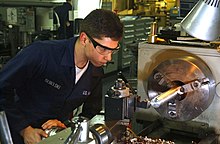
Back Metaalbewerking Afrikaans صنع الأدوات المعدنية Arabic Metalistería AST Металаапрацоўка Byelorussian Металообработка Bulgarian Treball dels metalls Catalan Kovodělnictví Czech Metelwaith Welsh Metalarbejde Danish Metallverarbeitung German

Metalworking is the process of shaping and reshaping metals in order to create useful objects, parts, assemblies, and large scale structures. As a term, it covers a wide and diverse range of processes, skills, and tools for producing objects on every scale: from huge ships, buildings, and bridges, down to precise engine parts and delicate jewelry.
The historical roots of metalworking predate recorded history; its use spans cultures, civilizations and millennia. It has evolved from shaping soft, native metals like gold with simple hand tools, through the smelting of ores and hot forging of harder metals like iron, up to and including highly technical modern processes such as machining and welding. It has been used as an industry, a driver of trade, individual hobbies, and in the creation of art;[1] it can be regarded as both a science and a craft.
Modern metalworking processes, though diverse and specialized, can be categorized into one of three broad areas known as forming, cutting, or joining processes. Modern metalworking workshops, typically known as machine shops, hold a wide variety of specialized or general-use machine tools capable of creating highly precise, useful products. Many simpler metalworking techniques, such as blacksmithing, are no longer economically competitive on a large scale in developed countries; some of them are still in use in less developed countries, for artisanal or hobby work, or for historical reenactment.
- ^ "Steampunk Metal Sculptures". Archived from the original on 2015-07-07. Retrieved 2012-08-30.